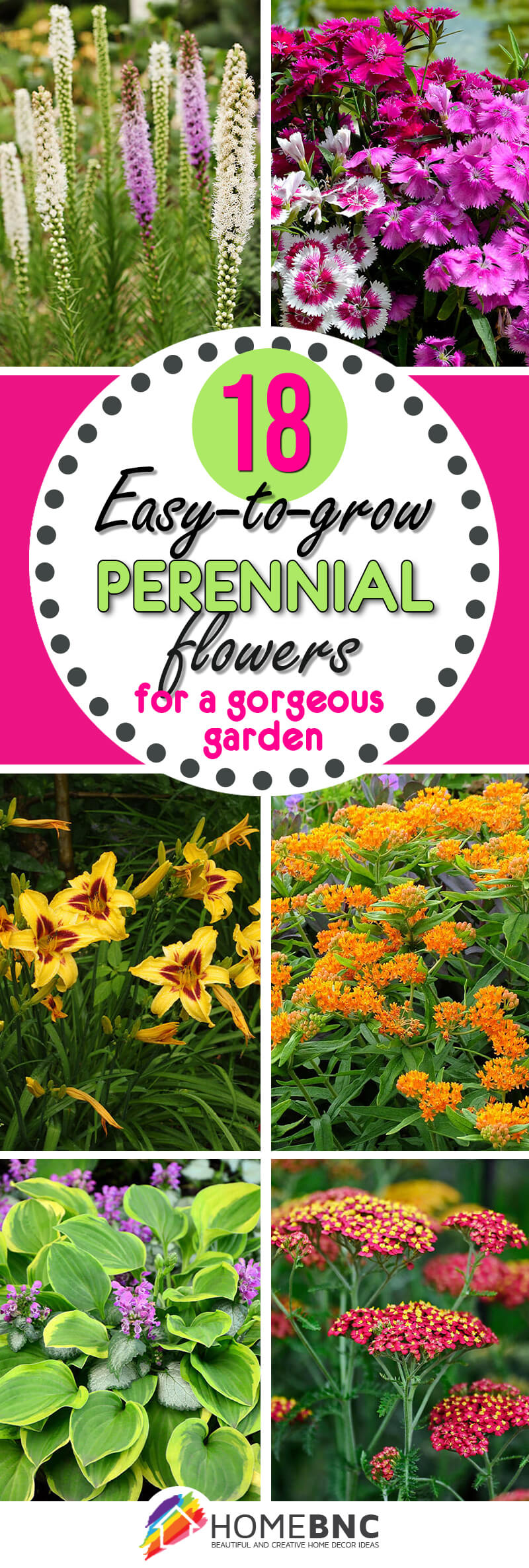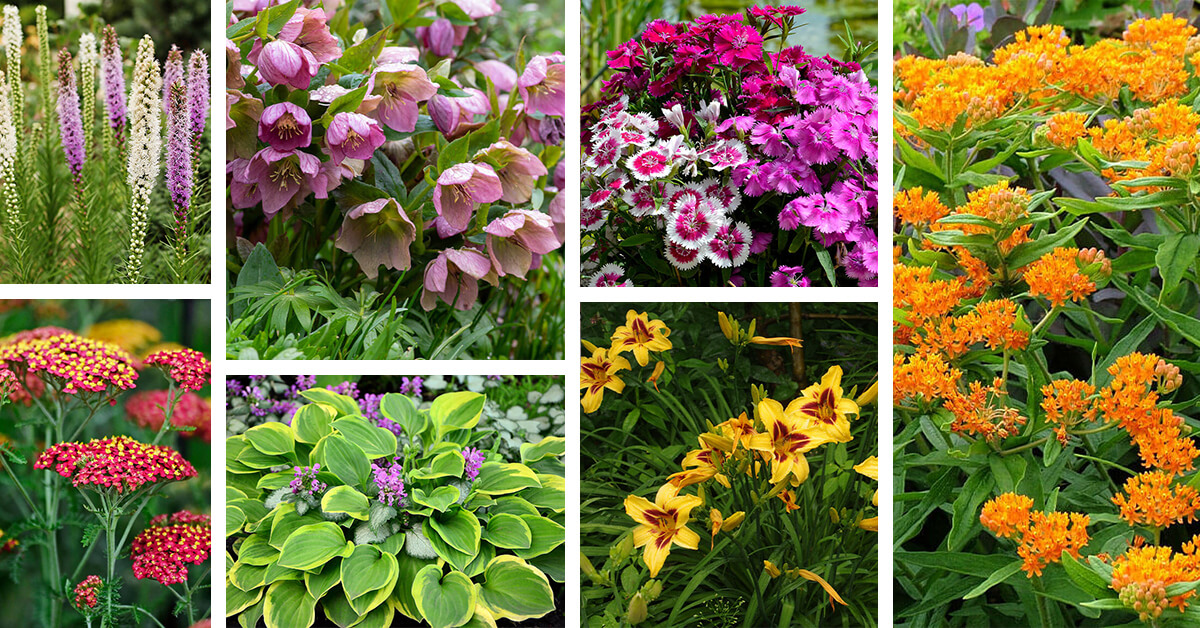Gardening can be hard work, both physically and mentally: apart from spending hours in the most uncomfortable position possible — i.e., kneeling in the hot sun — you have to keep in mind the specific needs and requirements of your plants. This one needs to be watered twice a week, that one daily, this other one has to be deadheaded, and don’t forget fertilizer… If you’re just getting into gardening, it can be a little intimidating, and even overwhelming.
Fortunately, there are plenty of beautiful ornamentals that don’t require much more than the occasional watering – if that. These plants are perfect for beginning gardeners because they’re so forgiving, and are sometimes nicknamed “plant it and forget it” because they thrive without any special attention at all.
Below, you’ll find 18 of the easiest to grow perennials, from huge anchor plants to low ground cover and everything in between. Be forewarned, though: none of these entries is truly a “plant it and forget it” perennial, simply because their aesthetic appeal will definitely remind you of their presence! Whether you’re a beginning gardener looking for “starter” plants or a seasoned pro trying to fill some “problem areas” in your yard, you’re certain to find a new favorite among these high-impact, low-effort perennials.
Key Takeaways
- You might think perennials are inherently easier to grow than annuals, if only because they don’t have to be replanted over and over again – but it’s not so. Perennials have to survive all four seasons in your garden, while annuals usually only have to deal with two.
- That said, perennials offer more bang for your buck, since they come back year after year – and many of the most popular ornamentals of all time – peonies, irises, carnations – are hardy, adaptable perennials.
- “Easy to grow” means different things in different areas. A perennial that’s easy to grow in deep shade, like hostas, will probably be very hard to grow in full sun – and vice versa. Likewise, you might think that a really drought-tolerant perennial will do just as well (maybe better) if it gets lots of water – but it will probably get root rot instead. Always make sure you know where you want to plant before you pick what to plant!
- Often, the easiest plants to grow in your garden are going to be plants that already grow wild in the area – i.e., native species. Native plants are better adapted to your local climate, of course, but they’re also more resistant to potential pests and diseases.
- There are all kinds of ways of propagating perennials, including stem cuttings, transplants, root divisions, and seed. Not all perennials are easy to grow by all of these methods, and even if they are, they may not perform the way you expect. For example, butterfly weed is quite easy to grow from seed… but doesn’t produce any flowers for the first three to four years after emerging!
- The very easiest-to-grow perennials will often naturalize in your garden – and possibly beyond. A naturalized plant is one that can survive year-round and replace itself with new seeds, growth, etc., meaning you’ll never have to re-seed or replant these species in your garden.
- Be careful about plants that are described as “naturalized.” It may sound like a dream come true, but the line between “easy to grow” and “weed” is easily crossed. You may find that the perennials you tended so lovingly when they were a small part of a big mixed border aren’t so lovable when they’ve choked out everything else!
- Finally, remember that “easy to grow” doesn’t just mean “easy to keep alive.” The easiest perennials to grow aren’t just hardy but low-maintenance – they don’t (mostly) need to be deadheaded, selectively pruned, or fertilized more than once a year or so.
- Lastly, remember that no list or website, however knowledgeable it might appear, knows your garden better than you! The easiest perennials to grow will always be the easiest perennials for you to grow, and those may not be on any list except your own! Let your experience guide you, and have fun!
18 Low-Maintenance and Easy to Grow Perennial Flowers for Effortless Beauty
1. Gayfeather, Blazing Star (Liatris spp.)
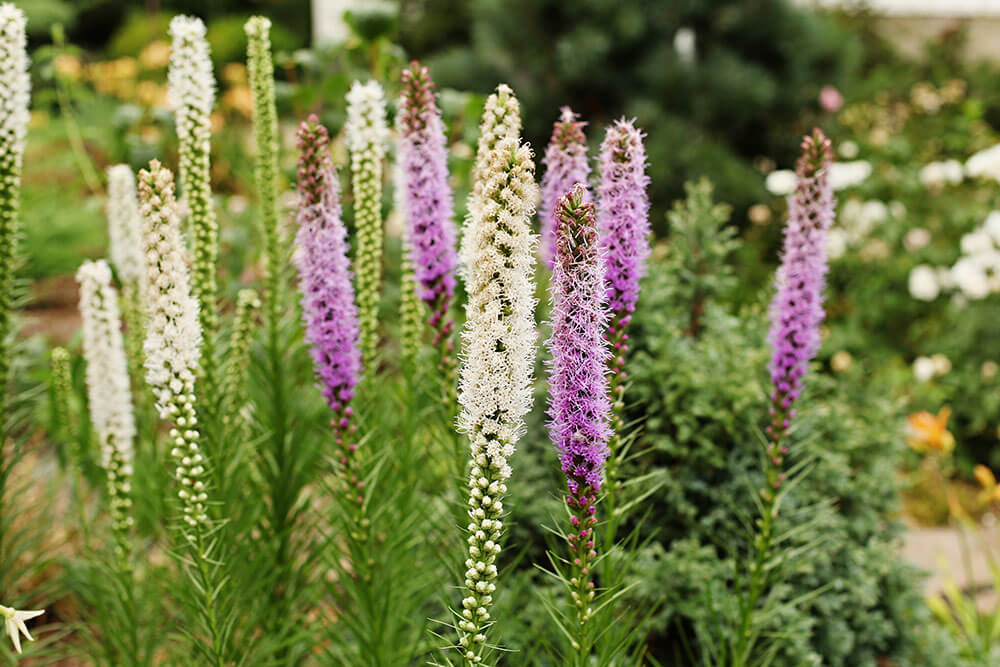
Gayfeather is a member of the family Asteraceae, which also includes sunflowers and daisies — but you might not guess it from the whorled, grass-like foliage and feathery, hot-pink flowers. Gayfeather does have one thing in common with sunflowers, however: it’s at its best in the hottest part of the summer, when the rest of your garden is drooping. It stands up to heat, drought, and humidity, yet is still impressively frost-hardy (to zone 3).
Gayfeather’s flowers are individually small, but make a big impact when they emerge by the dozens in spikes up to five feet long. Likewise, gayfeather lends itself to mass plantings, and makes a beautiful border or accent, contrasting with the bright yellows that characterize so many late-blooming perennials.
2. Yarrow (Achillea millefolium)
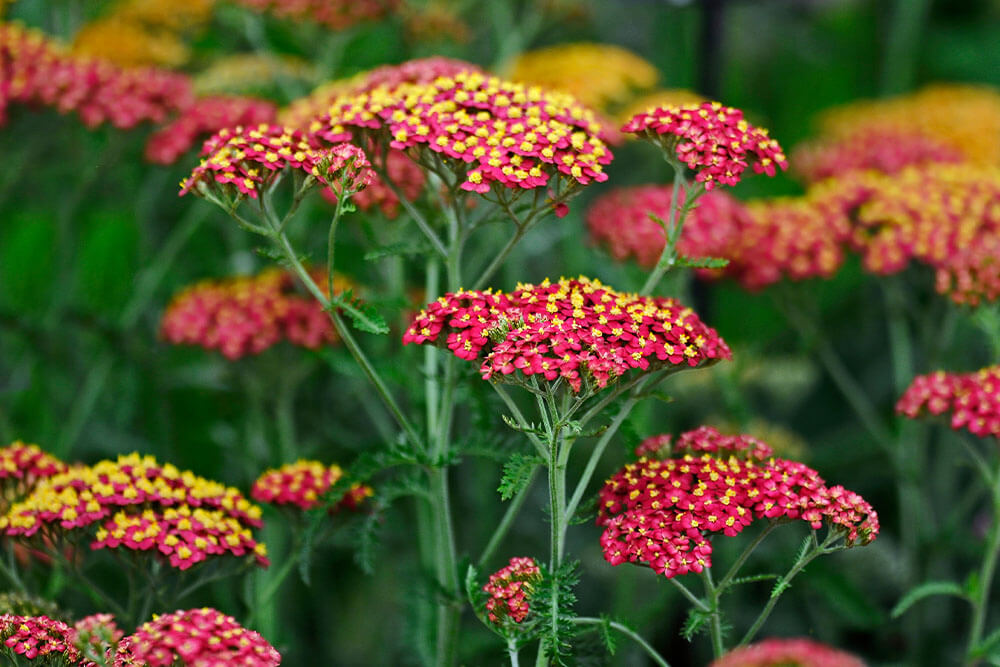
No list of “easy to grow perennials” would be complete without yarrow. Its showy clusters of flowers last all summer long, and come in a whole rainbow of pinks, yellows, and reds. Its finely compound foliage is almost as beautiful as its blooms, and gives the plants an almost fern-like appearance, quite at odds with their grow-anywhere attitude. And yarrow really will grow anywhere: hardy between zones 3 and 10, it would be hard to find a garden anywhere in the country where yarrow won’t make itself at home.
In fact, if yarrow has a problem, it’s that it’s a little too easy to grow. Yarrow spreads via underground rhizomes, and can get out of hand if not monitored closely. One way to avoid this problem is simply to give it all the space it needs: it makes a lovely three-season ground cover, and can be mowed down to the ground in winter without hurting the plants. Try a mix of colors for a truly stunning “confetti” effect!
3. Purple Coneflower (Echinacea purpurea)
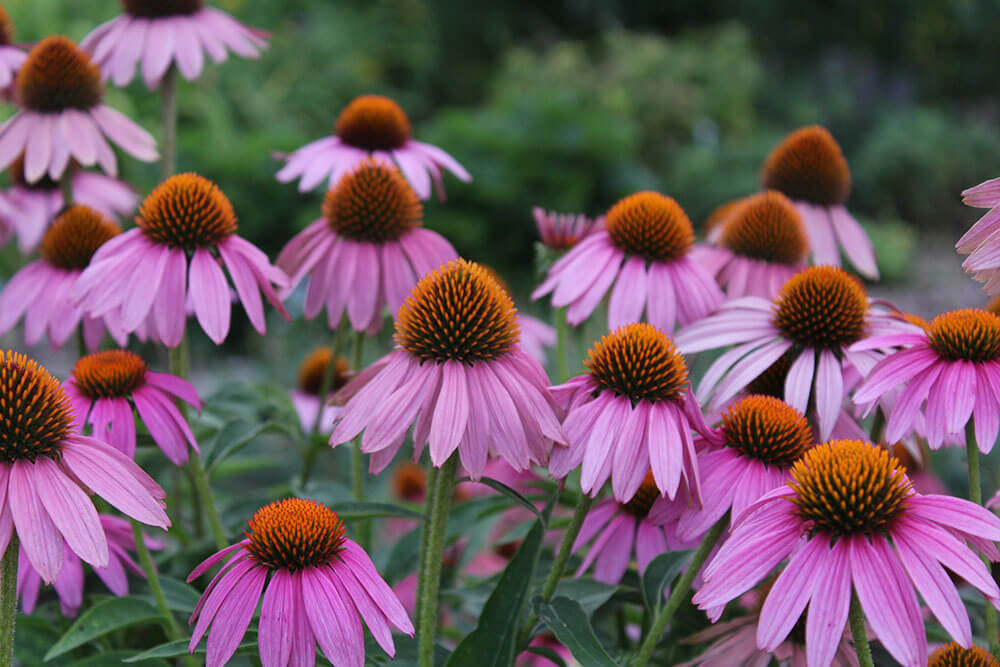
Purple coneflower is one of the most popular native perennials, and with good reason: there aren’t many ornamentals, native or otherwise, that give such a big return on such a little investment. It’s easy to grow from seed, Hardy from zone 3 to 8, tolerates a huge range of soil textures, and is highly resistant to drought and disease. It’s even shade tolerant, although it blooms best in full sun.
Blooming is where purple coneflowers really shine. Its large, showy flowers resemble sunflowers, but the “cone” at the center of each blossom gives it a unique appearance. Despite the name, they come in a range of colors, including red, white, and yellow — sometimes all on the same plant! The flowers also attract butterflies in the summer and songbirds in the fall. Whether mixed in with other summer bloomers or massed in a border or accent planting, it’s a fantastic, low-maintenance addition to any garden.
4. Pinks (Dianthus spp.)
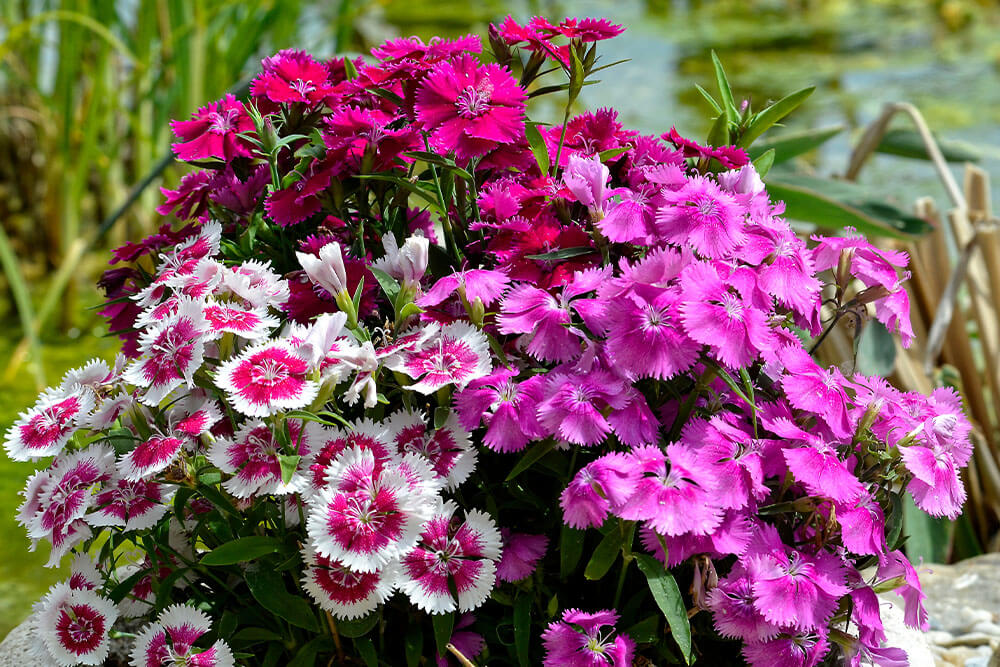
Pinks — and their close relatives, carnations — are part of the genus Dianthus, which is Greek for “divine flower.” The name is well earned, as these perennials aren’t just divinely beautiful — they also smell divine, with a sweet scent reminiscent of cloves that’s quite perceptible when they’re planted en masse.
They’re also divinely easy to grow, and surprisingly hardy given the delicate appearance of their fringed blooms. Cheddar pinks (D. gratianapolitanus) and their hybrids are probably the toughest of all, hardy between zones 3 and 9, and more tolerant of heat and drought than other varieties. The ‘Firewitch’ hybrid has become especially popular for its ability to bloom twice or even three times in a single season.
5. Daylily (Hemerocallis spp.)
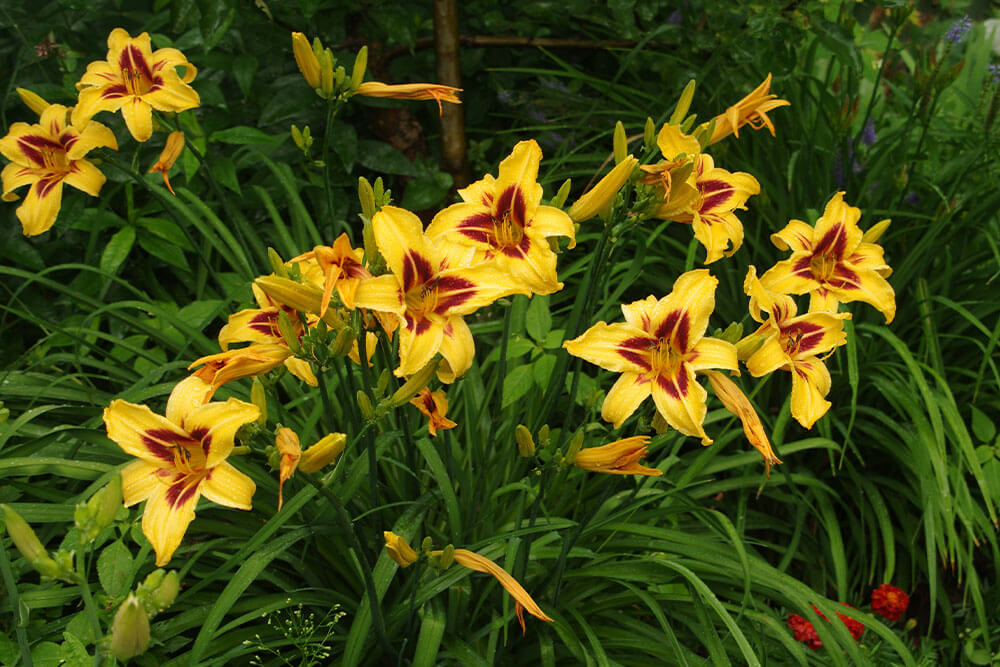
Daylilies are named for the extremely brief lifespan of their gorgeous blooms: each flower lasts only a single day! Fortunately, each plant produces numerous flowers over the course of a month or so — and a number of hybrids bloom for much longer, flowering consecutively all summer long. The elegant, sword-like foliage of the plants provides interest even when they’re not in bloom.
Daylilies are some of the toughest bulbs you can find — some of the toughest ornamentals, period. They love dry, rocky, and infertile soil, and handle drought and frost equally well, with different varieties suitable between zones 2 and 11 — in other words, the entire lower 48 states! Daylilies also naturalize readily, and don’t need to be planted year after year; once the plants are established, all you’ll need to do is divide the clumps every few years to stimulate more vigorous growth.
6. Japanese Spikenard (Aralia cordata)
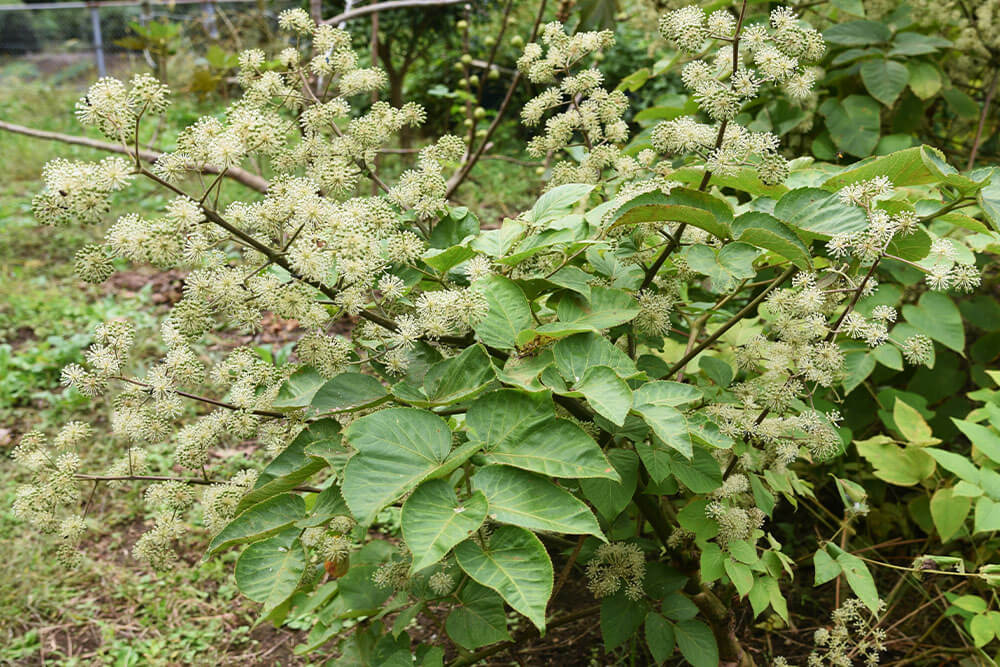
Expect big things of Japanese spikenard, a relatively recent introduction to American gardens – in more ways than one. It’s a big plant: although it’s a herbaceous perennial, it can easily reach the size of a shrub or even small tree, and its huge chartreuse leaves can grow to be three feet long! Its cream-colored flowers are minuscule individually, but it produces them in large numbers, arranged in attractive spherical clusters that last from late summer to fall.
Then again, there’s nothing big about the effort required to grow Japanese spikenard. It thrives in part to full shade, has no serious pests or diseases, and is frost-hardy to zone 3. Whether grown as an eye-catching anchor or a lush border, Japanese spikenard will make a big impact with very little work.
7. Columbine (Aquilegia spp.)
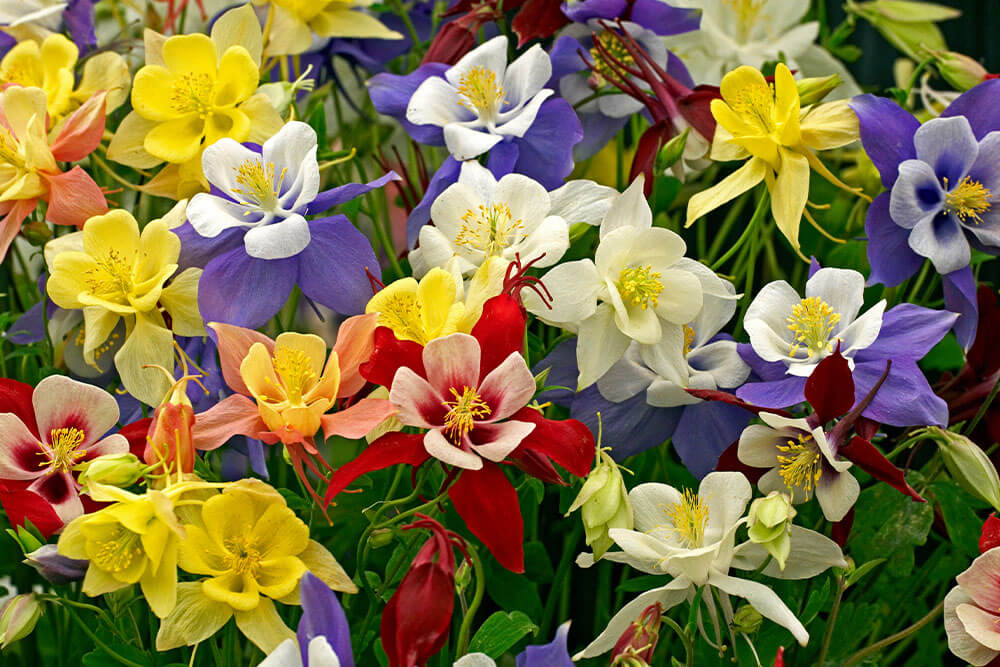
Gardeners on both sides of the Atlantic have long appreciated columbines for their striking flowers as well as their adaptability. They’re extremely easy-going plants, and will grow in almost any well-drained soils with next to no maintenance. While most varieties need a bit of extra water in their first year, they’re exceptionally drought-tolerant once established, and even thrive in dry shade, so they’re a great choice for “problem areas” where other ornamentals just don’t seem to grow.
Columbines are well-known for their unique blossoms, which have long, claw-like spurs and are surprisingly long-lasting. Their fern-like foliage retains interest long after the flowers have dropped off, and makes a lovely, deer-resistant ground cover, especially in dry or shady locations like under oak trees. With over 80 species and countless varieties available, you’re certain to find some that are just right for your garden.
8. Peonies (Paeonia spp.)
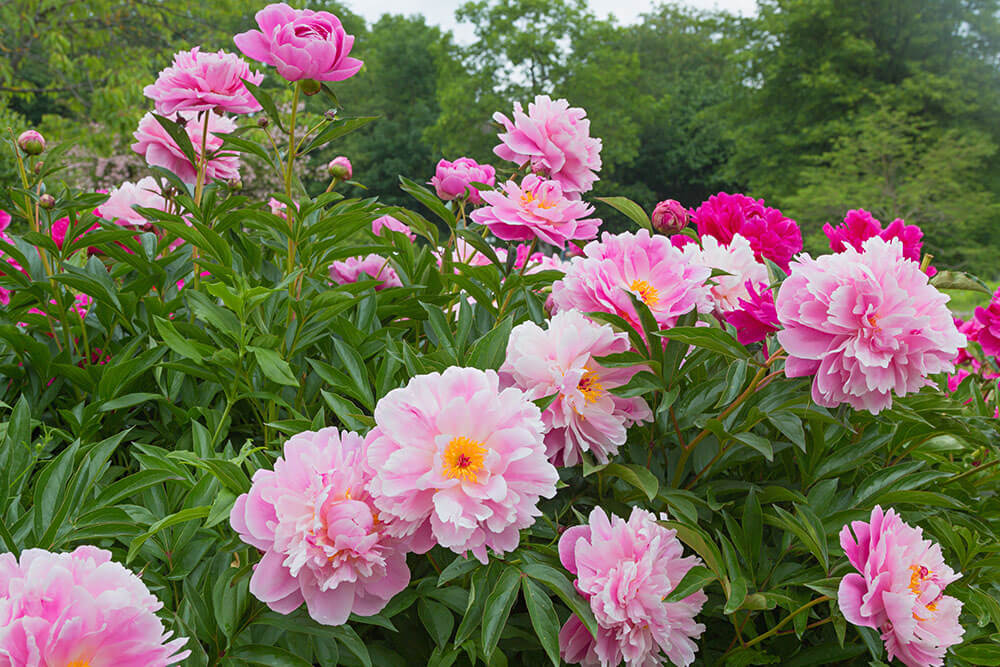
Peonies are, without a doubt, among the most gorgeous and have a reputation as being somewhat finicky plants – but this isn’t quite true. Problems with peonies are usually caused by planting them in unsuitable locations, rather than neglect. First, they can become sickly or stressed in high humidity, which is not at all difficult to prevent. Plant them in the open, away from walls or other large plants, and don’t overwater (mature plants are quite drought-tolerant).
Peonies also need prolonged cold temperatures (or “chilling hours”) to bloom. There’s no way around this, but fortunately, there are many varieties of peonies available with fairly modest requirements, and will bloom beautifully as far south as Dallas or Atlanta. If grown in the right spot, both on the map and in your garden, peonies are almost maintenance-free – and they’re also extraordinarily long-lived. Fifty year-old and even hundred year-old peonies are not at all uncommon – talk about “plant it and forget it!”
9. Hostas (Hosta spp.)
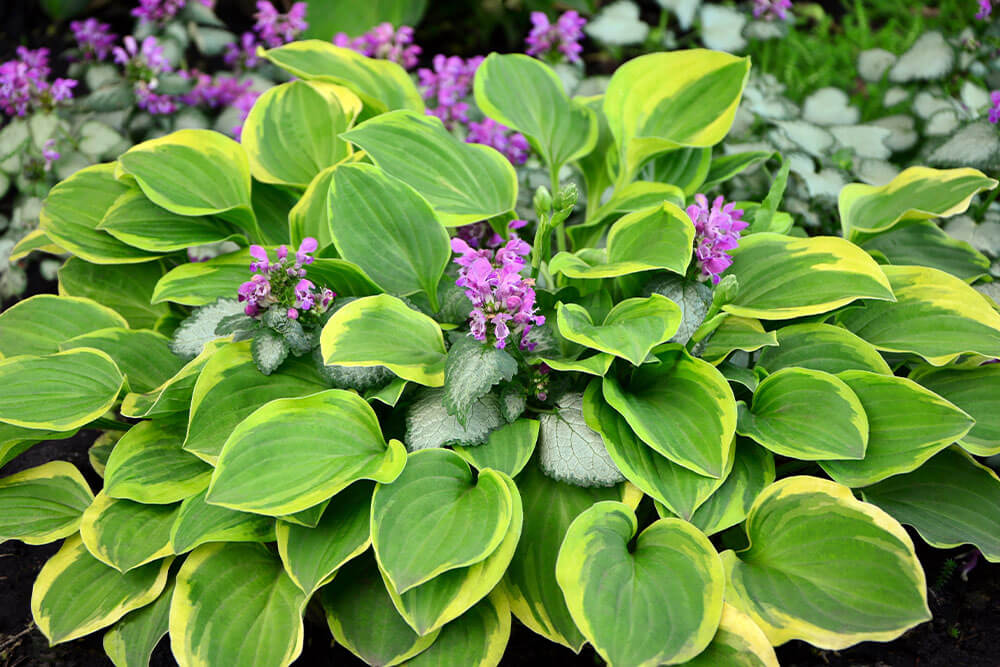
If your garden gets a lot of shade, you’ll love hostas, which are some of the most popular shade plants around. Also called plantain lilies, these clump-forming perennials thrive even in the deepest shade, though many varieties are happy in part shade as well. They’re known mostly for their lush foliage, which comes in a rainbow of colors and textures depending on the variety — but their flowers are equally beautiful, hanging like bells from long stalks.
One reason hostas are so popular is that despite their exotic, almost tropical appearance, they’re actually quite easy to grow. Once they’re established, these plants have few problems, and require very little maintenance to keep them happy. The only serious issues to watch for are slugs and snails, which have a special fondness for hostas.
10. Russian Sage (Salvia yangii)

Russian sage is a fantastic, long-blooming sage that is one of the very best and easiest ornamental sages. Drought-tolerant, deer-resistant, and disease-free, it’s also one of the most adaptable species of sage, suitable for planting between zones 4 and 9. Plants grown from seed tend to grow slowly in the first year or two, but once they establish their root system they are amazingly robust (plants can easily reach 3 to 4 feet tall).
Russian sage doesn’t skimp on aesthetic appeal, either: its huge spikes of blue flowers last all summer long, and its silvery foliage remains attractive throughout the growing season. It’s not the easiest to grow from seed — seeds take several months to germinate, and plants grown from seed can be leggy — so go with potted plants or even from stem cuttings from a mature plant.
11. Bearded Iris (Iris spp.)
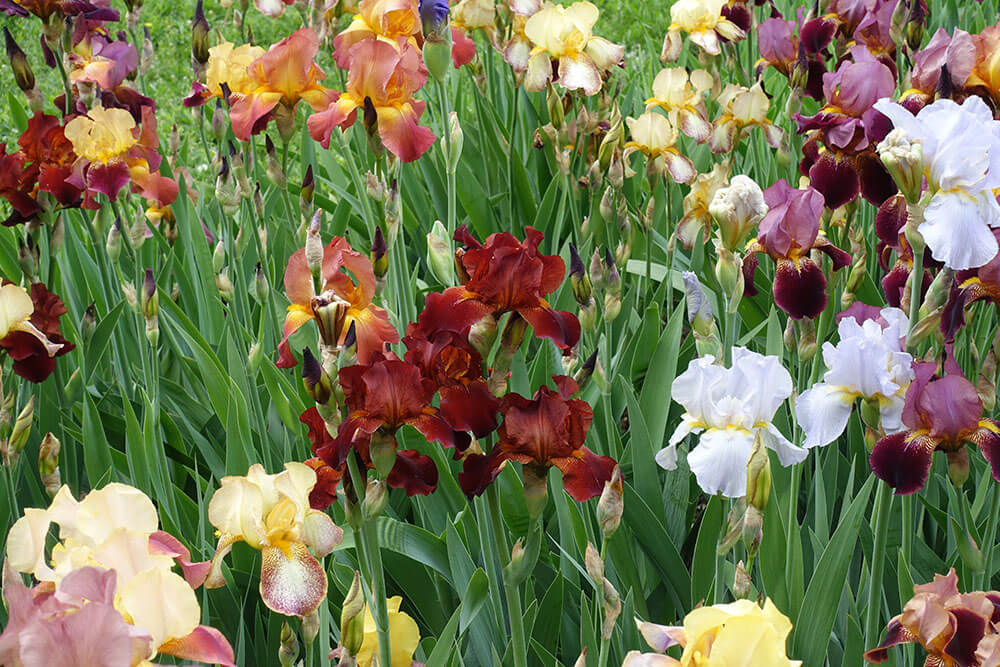
There are few perennials that are more elegant, and simultaneously less fussy, than the bearded iris, which grows between zones 3 and 10, and will bloom reliably year after year on nothing more than full sun and a little water. They’re resistant to most pests (including deer and rabbits), and they handle drought far better than their lush appearance might suggest. They’re so easy to grow, in fact, that they often naturalize in gardens, meaning that all you’ll have to do is divide plants when they get crowded.
The hardest part about planting irises isn’t watering or fertilization — it’s simply picking which irises to plant! Thousands of cultivars are available in every imaginable shade and size, from tiny dwarf varieties to imposing four-foot hybrids.
12. Black-eyed Susan (Rudbeckia fulgida)
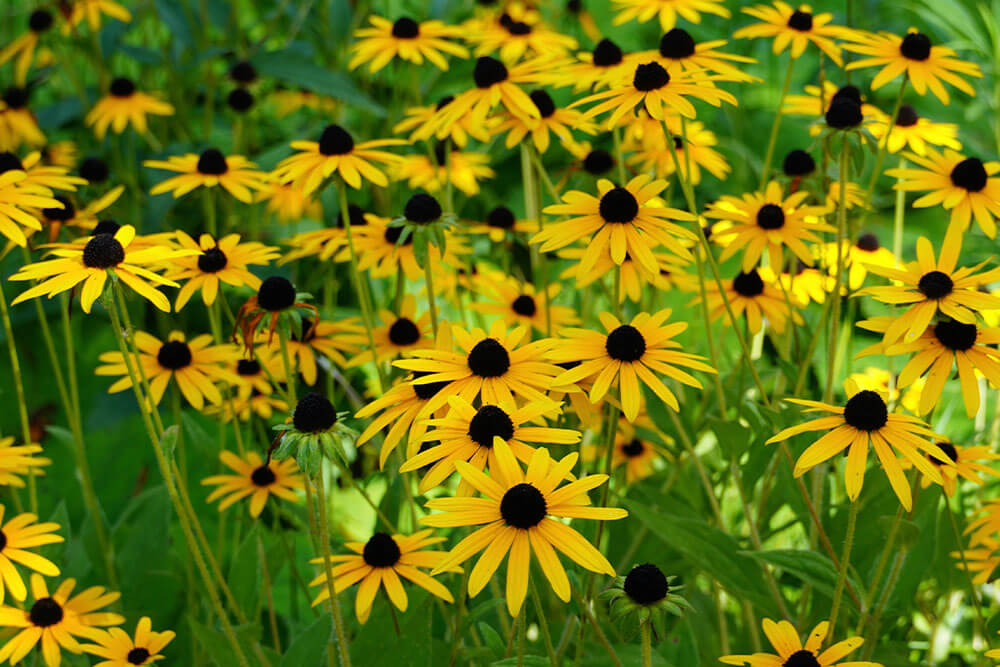
Black-eyed Susans are hardy, adaptable native perennials in the sunflower family, and even resemble miniature sunflowers in bloom. They stand up amazingly well to heat and drought, and thrive in dry, rocky soils, but they’re also cold-hardy to zone 3, and their rough foliage makes them unpalatable to deer and other garden pests. On the other hand, they’re very attractive to many butterflies and other pollinators in the summer and fall – and songbirds pick the seeds from spent heads in the winter, so no need to deadhead your plants!
Black-eyed Susans spread via underground rhizomes, which makes them easy to propagate by division, but left to their own devices they will naturalize easily, forming dense stands that flower for months at a time. While wild plants may reach three feet high, a number of cultivars are available, including dwarf cultivars that are perfect for borders or even a low-maintenance ground cover.
13. Pincushion Flower (Scabiosa spp.)
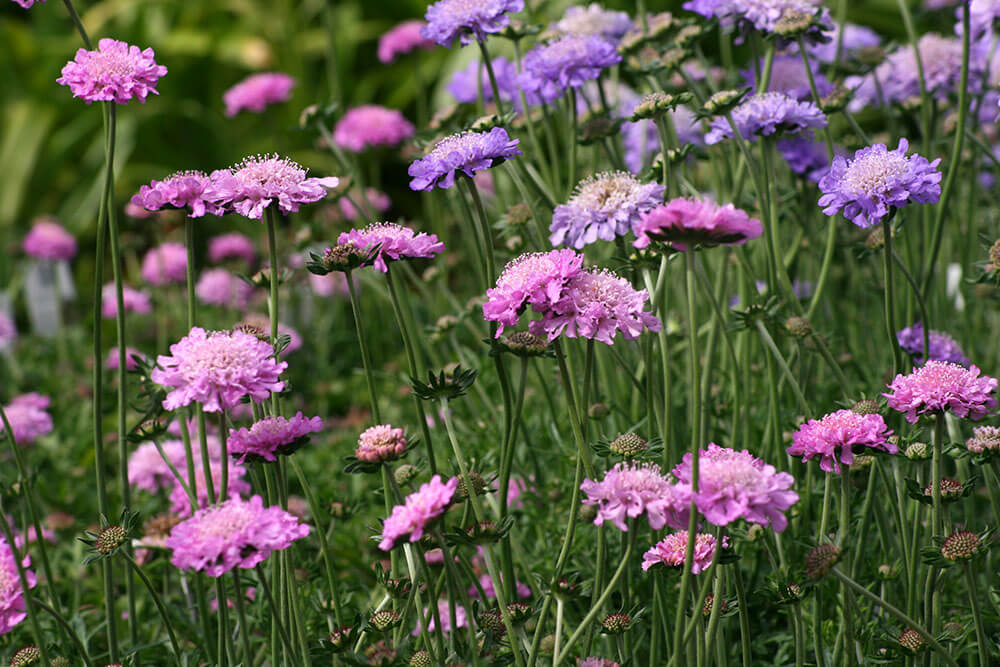
When it comes to long-blooming perennials, you can’t get much better than a pincushion flower: these low, bushy perennials (some species are annuals) start blooming soon after the last frost, and often bloom continuously until the beginning of winter! Their blue and purple flowers really look like pincushions stuck with pins, and their long stems make them perfect for bouquets and cut arrangements. You can deadhead plants to encourage reblooming, but it’s not necessary, and the spent heads remain attractive after the flowers have dropped off.
When it comes to care, pincushion flowers have only one requirement: well-drained soil. They are quite tolerant of soil texture and pH, and even do well in alkaline soils, but standing water or slow drainage can quickly lead to root rot. That said, if you can keep their feet dry, they won’t ask for much else in return, and grow quickly enough that a few starter plants, divided yearly, can fill a border or accent planting after only a few years.
14. Lenten Rose (Helleborus x hybridus)
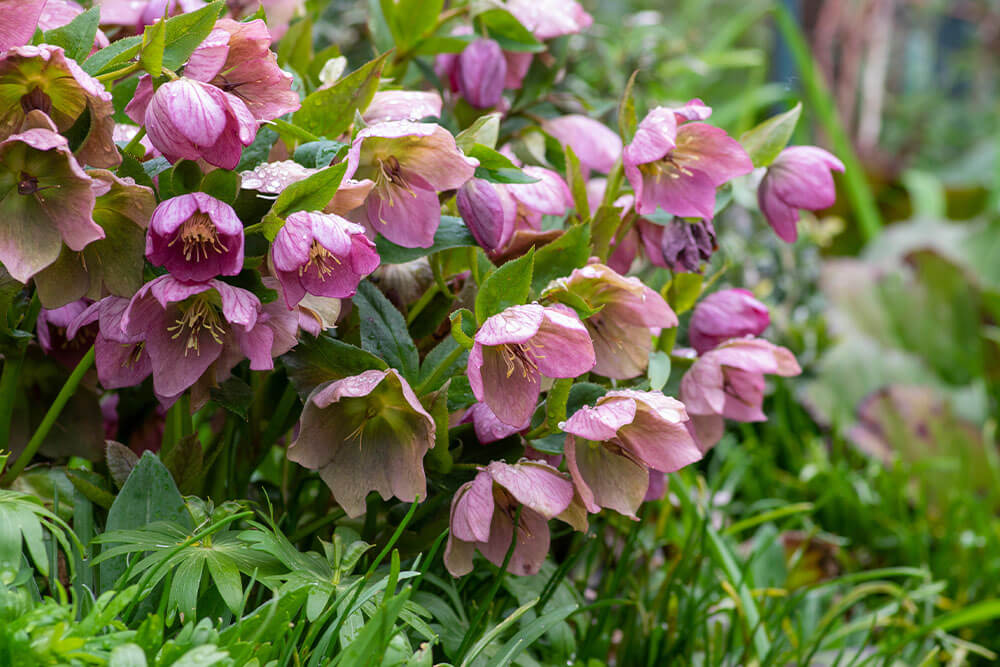
Lenten rose is easily grown between zones 5 and 9, but plants in protected areas can survive further north. It thrives in full sun to part shade, and once established is quite drought-tolerant due to its large and extensive root system. The evergreen foliage is handsome and unique, resembling palm fronds – and it’s toxic to deer and rabbits, so pests are no problem!
Its common name comes from its flowering period: about six weeks in late winter and early spring, often coinciding with the eponymous holiday. The flowers, which come in a range of shades from white to deep purple, look a little like hollyhocks or hibiscus, but are really like no other common ornamentals. They’re followed by long seed pods that are equally interesting, and reliably produce viable seed if allowed to ripen. While hardy and low-maintenance, lenten rose is a slow-growing plant in the first years of its life, so it’s best started from divided clumps or established plants.
15. Bigroot Geranium (Geranium macrorrhizum)
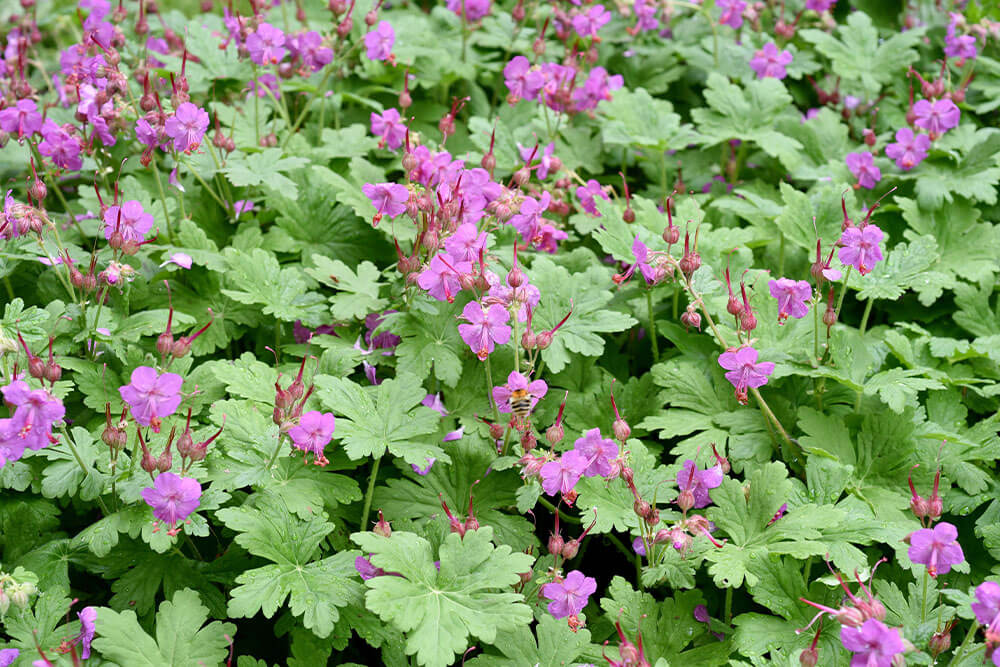
There are hundreds of species of geranium, and most of them are easy to grow – but bigroot geranium might just be the easiest of all. This low-growing, mat-forming perennial spreads by means of rhizomes, and makes a great groundcover, especially when interplanted with other perennials: its foliage is dense enough to block weeds, but low enough to keep it from interfering with neighboring plants.
It’s also one of the hardiest geraniums, as well as one of the lowest-maintenance. It’s drought-tolerant, frost-hardy (to zone 4), and grows well in both sandy and clayey soils. Its profuse pink flowers are quite long-lived compared to other geraniums, and it will rebloom late in the season even if plants aren’t deadheaded. Even division is a snap with bigroot geranium, because its root system is so shallow that plants can be easily removed and transplanted.
16. Betony (Stachys officinalis)
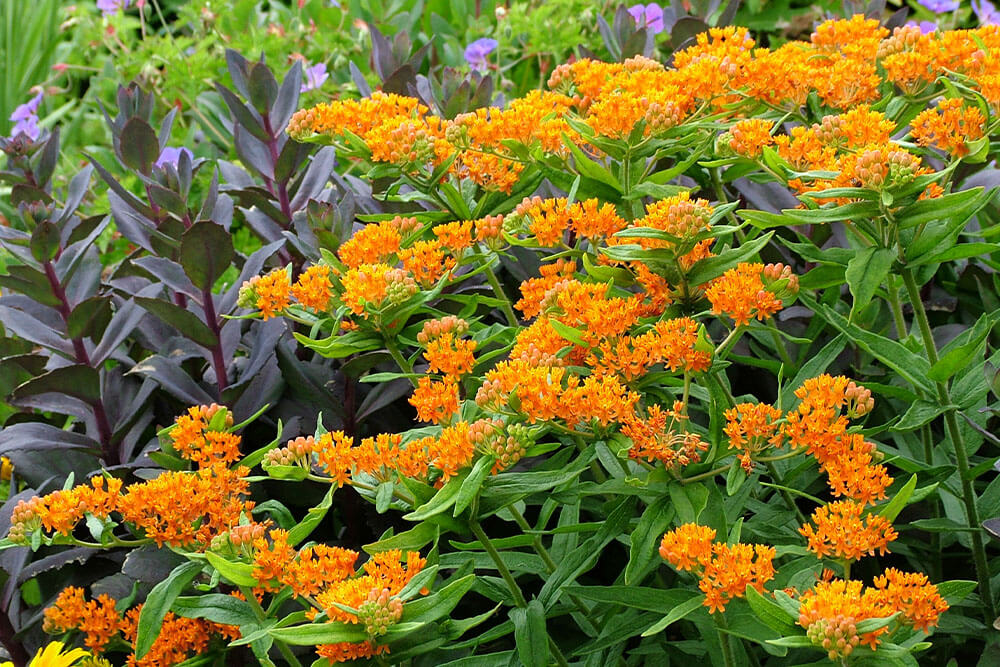
Betony is closely related to lamb’s ear (S. byzantina), but it’s much showier: where lamb’s ear is grown mostly for its silvery foliage, betony really wows with its tall spikes of magenta blooms each spring. The flowers are attractive to pollinators, and relatively long-lived, lasting throughout summer and into autumn. Its foliage is quite different from lamb’s ear, but equally beautiful: glossy, dark green, and deeply veined, it retains interest long after flowering.
Betony does have one thing in common with lamb’s ear, though, which is that it’s a snap to grow. In well-drained soils from zones 4 to 8, it requires very little maintenance and can be divided in the fall. Betony produces well-defined clumps rather than spreading, which makes it a good choice for edging, borders, and rock gardens.
17. Butterfly Weed (Asclepias tuberosa)
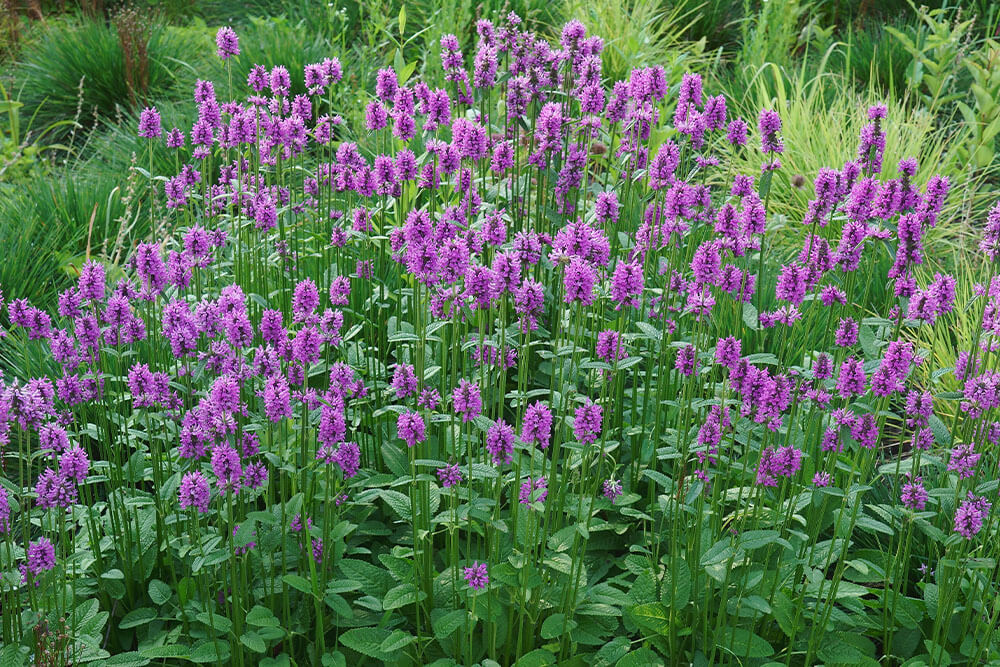
Butterfly weed is a lovely, exceptionally long-blooming native milkweed that grows from a large and very deep taproot, which helps it withstand drought even in the toughest and most exposed locations. While its heat tolerance has made it a popular choice for Southern gardens, butterfly weed also handles cold remarkably well, and is frost-hardy to zone 3.
Its vibrant orange flowers bloom for up to three months at a time, and will often rebloom after deadheading. It’s not just butterflies that love these nectar-packed flowers: hummingbirds, bees, and pretty much any pollinator in the neighborhood will flock to them all summer long! Butterfly weed is also a host plant for many butterflies, including the famed Monarch butterfly, but keep in mind that plants hosting caterpillars may look a little ragged by the end of spring. (Don’t worry, they’ll survive just fine!)
18. Aromatic Aster (Symphyotrichum oblongifolium)
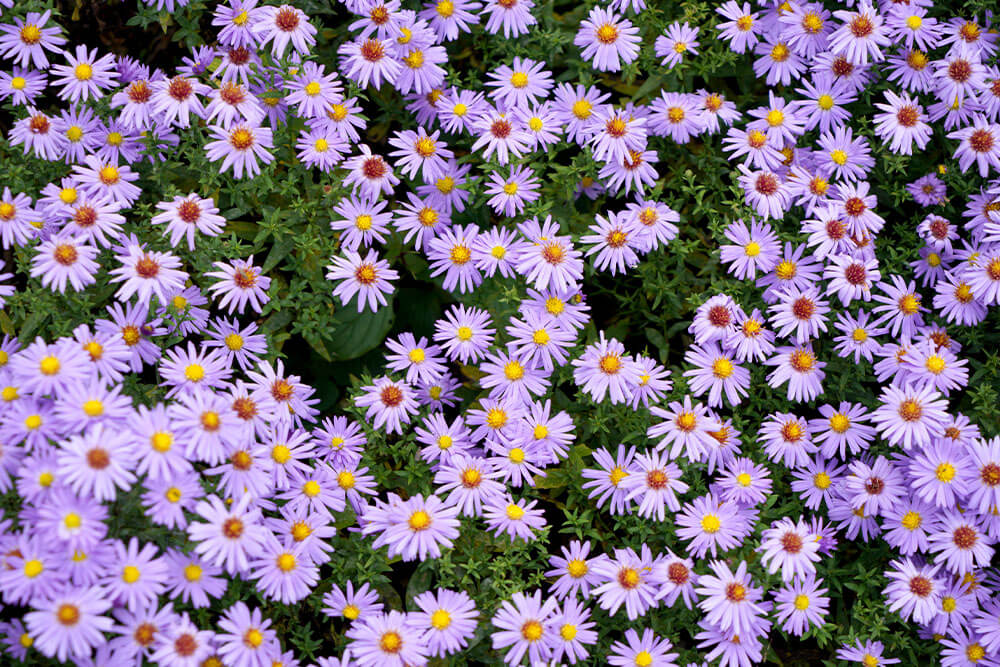
Aromatic aster is native to the eastern US, and grows well between zones 3 and 8. It’s a tough plant, tolerant of a wide range of soil textures and moisture, and forms dense mounds of fragrant foliage that positively explode into bloom in autumn. The profuse daisy-like flowers are lavender to purple and fairly large for asters (about an inch in diameter), and often bloom for months at a time, from early fall until after the first frost.
Aromatic aster is just one of the many showy, fall-blooming native asters available to gardeners. New England aster (S. noviae-angliae) is nearly twice as tall, but otherwise quite similar in appearance, while heath aster (S. ericoides) has white flowers that are smaller (but more numerous); it also handles heat better than most other species. Each of these species has its own strengths, but all are spectacular – and spectacularly easy to grow – fall blooming perennials.
18 Perennial Flowers for Simple and Spectacular Garden Landscapes
So there you have it: 18 perennials that will impress year after year, with almost no maintenance or effort. It’s certainly not a complete list, but hopefully this list has shown you that whether you’re looking for a show-stopping specimen, a no-fuss border, or a groundcover for the stubborn bare spots in your yard, there’s probably an attractive, easy-to-grow perennial perfect for the job.
One of the great things about gardening is that it’s only as much work as you want it to be. If you want to be in daily contact with your garden, you certainly can – but if you just want to brighten the view from your back window, that’s okay too! The world of plants is so colorful and diverse that it’s no exaggeration to say.
[wp-faq-schema title=”Frequently Asked Questions About Easy to Grow Perennial Flowers” accordion=1]